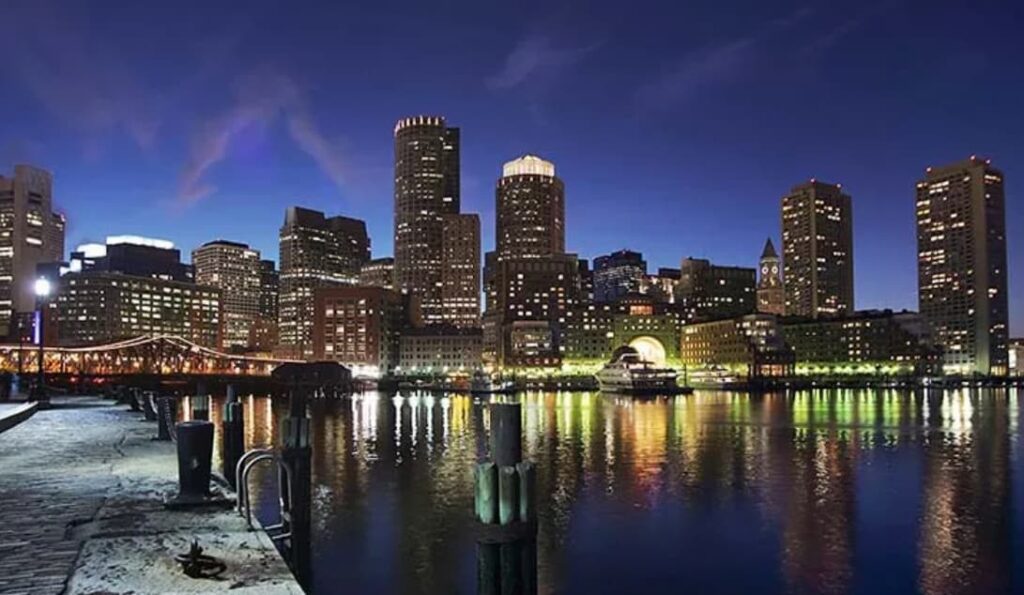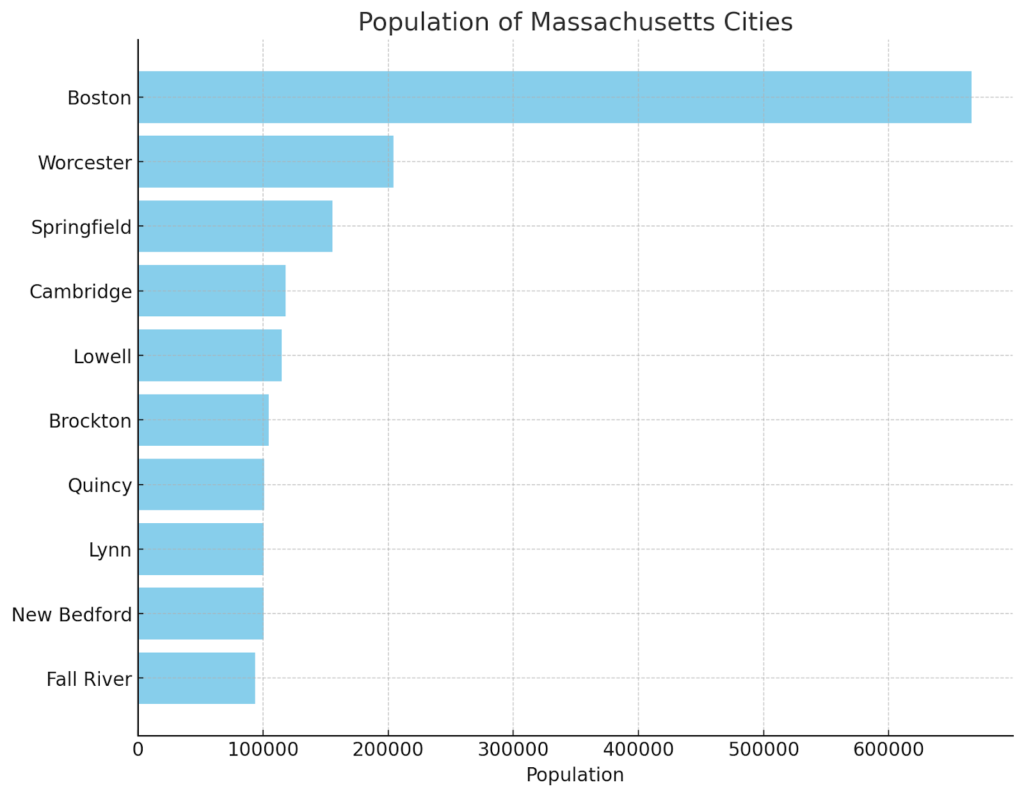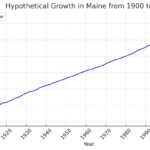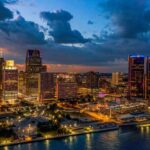
Massachusetts, a state renowned for its significant historical background, vibrant cultural scene, and academic excellence, is a diverse tapestry of cities each with its own unique charm and character. From the bustling streets of Boston to the serene landscapes of Fall River, the Commonwealth of Massachusetts is a blend of historical richness, technological innovation, and educational prowess. This article delves into the ten most populous cities in Massachusetts, providing a detailed look at what makes each city stand out.
Boston, the state’s capital, leads as a hub of historical significance and modern dynamism. Home to the Freedom Trail, prestigious universities like Harvard and MIT, and a thriving tech sector, Boston encapsulates the essence of Massachusetts’ innovative spirit and its deep-rooted past. Worcester, known as the “Heart of the Commonwealth,” showcases a rich industrial history and a vibrant cultural scene, with attractions like the Worcester Art Museum and the annual Worcester Music Festival.
Springfield, located in the scenic Connecticut River Valley, is famous for being the birthplace of basketball and hosts the Naismith Memorial Basketball Hall of Fame. It also boasts a diverse array of museums, including the Springfield Museums complex, which celebrates art, science, and history. Lowell, with its historic mills and waterways, offers a glimpse into the state’s industrial revolution past, while also embracing the future with its vibrant arts community and university life.
Cambridge, aside from housing esteemed institutions such as Harvard University and the Massachusetts Institute of Technology, is a center for biotech innovation and boasts a lively arts and culinary scene. New Bedford, the “Whaling City,” preserves its maritime heritage while evolving into a center for the arts and renewable energy. Quincy, known as the “City of Presidents,” honors its native sons John Adams and John Quincy Adams, and offers rich historical sites alongside modern amenities.
Brockton, the “City of Champions,” celebrates its sporting legacy, including boxing legend Rocky Marciano, and fosters a strong community spirit. Lynn, with its stunning shoreline and historic architecture, is undergoing a renaissance, becoming a hub for art, culture, and economic development. Lastly, Fall River’s waterfront setting, historical attractions, and Lizzie Borden Museum highlight Massachusetts’ multifaceted character, combining scenic beauty with intriguing stories. Together, these cities embody the spirit of Massachusetts—a state that cherishes its past while boldly stepping into the future, making it an endlessly fascinating place to explore. So let’s take a detailed look!

What are the Top Massachusetts Cities by Population?

1. Boston (Population: 665,945)
Boston, the state capital and largest city, is not just the economic and cultural heart of Massachusetts but also a center of American history. Home to the Freedom Trail, numerous universities including Harvard and MIT nearby in Cambridge, and championship-winning sports teams, Boston is a blend of the old and new. The city’s innovation sector is thriving, with technology, biotech, and education leading the way. Boston’s diverse neighborhoods, from the Italian-flavored North End to the historically significant Beacon Hill, offer a mosaic of experiences for residents and visitors alike.
2. Worcester (Population: 204,191)
Worcester, known as the “Heart of the Commonwealth,” is a testament to Massachusetts’s industrial past and its innovative future. The city’s revival is evident in its bustling downtown area, the renovation of the historic Union Station, and the growth of its healthcare and biotech industries. Worcester’s cultural life is vibrant, with institutions like the Worcester Art Museum and the Hanover Theatre attracting arts and culture enthusiasts. The city’s colleges and universities, including Worcester Polytechnic Institute and Clark University, contribute to a youthful and dynamic atmosphere.
3. Springfield (Population: 155,305)
Springfield, located on the banks of the Connecticut River, is known for its pioneering spirit. The city is the birthplace of basketball and home to the Naismith Memorial Basketball Hall of Fame, a must-visit for sports fans. Springfield’s cultural scene is rich, with the Springfield Museums offering a quad of art, history, and science exhibitions. The MGM Springfield casino adds to the city’s entertainment options. Springfield’s economy is supported by education, health services, and manufacturing, reflecting a diverse and resilient economic base.
4. Cambridge (Population: 117,962)
Cambridge is synonymous with academia and innovation. Home to Harvard University and the Massachusetts Institute of Technology (MIT), the city is a global hub for education, research, and technology. Cambridge’s vibrant squares, such as Harvard Square and Kendall Square, are centers of activity, offering an array of bookstores, cafes, and shops. The city’s entrepreneurial ecosystem, supported by numerous startups and tech companies, makes it a magnet for talent. Cambridge’s cultural landscape is rich, with museums, galleries, and theaters contributing to a lively community.
5. Lowell (Population: 114,737)
Lowell’s history as a center for textile manufacturing is still visible in its preserved mills and the Lowell National Historical Park, which offers a glimpse into the city’s industrial past. Today, Lowell is a diverse community with a vibrant arts scene, exemplified by the Lowell Folk Festival and the presence of artists’ lofts and galleries. The University of Massachusetts Lowell is a key institution, contributing to research and innovation. Lowell’s multicultural environment is celebrated through various festivals and restaurants, offering a taste of global cultures.
6. Brockton (Population: 104,713)
Brockton, known as the “City of Champions” for its boxing heritage, is a city with a rich sports legacy and a resilient spirit. The city’s revitalization efforts are evident in its upgraded public spaces and the development of the downtown area. Brockton’s school system is recognized for its innovation, and the city’s healthcare facilities, including the Brockton Hospital, are significant to the region’s health services. The diversity of its population adds to the city’s cultural richness, making it a community with a strong sense of identity.
7. Quincy (Population: 100,981)
Quincy, known as the “City of Presidents” for being the birthplace of Presidents John Adams and John Quincy Adams, boasts a significant historical heritage. The Adams National Historical Park provides insight into the early American history. Quincy’s proximity to Boston makes it a desirable location for residents and businesses alike. The city’s redevelopment efforts, particularly in the Quincy Center, aim to enhance its appeal as a vibrant urban center. Quincy’s diverse culinary scene, especially its Asian cuisine, is noteworthy, reflecting the city’s multicultural makeup.
8. Lynn (Population: 100,653)
Lynn, with its historic reputation as a shoe manufacturing hub, has evolved into a city known for its cultural diversity and artistic community. The city’s waterfront redevelopment is enhancing its scenic beauty and attracting new businesses and residents. Lynn’s cultural scene is vibrant, with murals, art galleries, and the Lynn Auditorium hosting a variety of events. The Lynn Woods Reservation offers natural beauty and recreational activities, making the city a blend of urban and natural landscapes.
9. New Bedford (Population: 100,620)
New Bedford, historically the world’s most famous whaling era seaport, is today celebrated for its rich maritime history and its vibrant arts and cultural scene. The New Bedford Whaling Museum is a focal point for visitors interested in the city’s heritage. The city’s working waterfront is still active in the fishing industry, contributing to its economy. New Bedford’s arts community is thriving, with galleries, studios, and the Zeiterion Theatre enriching the cultural landscape. The city’s annual Working Waterfront Festival celebrates its maritime culture.
10. Fall River (Population: 93,638)
Fall River’s landscape is dominated by the Quequechan River, which has played a significant role in the city’s development as a textile manufacturing hub. Today, Fall River is known for its cultural diversity, historic architecture, and the Battleship Cove maritime museum, home to the largest collection of World War II naval vessels. The city’s revitalization efforts are visible in its waterfront developments and the preservation of its historic mills. Fall River’s culinary scene, especially its Portuguese cuisine, reflects the city’s rich cultural tapestry.
These cities, each with its own story and unique offerings, highlight the diversity and vibrancy of Massachusetts. From the academic excellence of Cambridge to the historical richness of Quincy, the Commonwealth’s cities offer a blend of history, culture, innovation, and community spirit that defines Massachusetts as a state of significance in the American narrative.
Last modified: February 28, 2024

